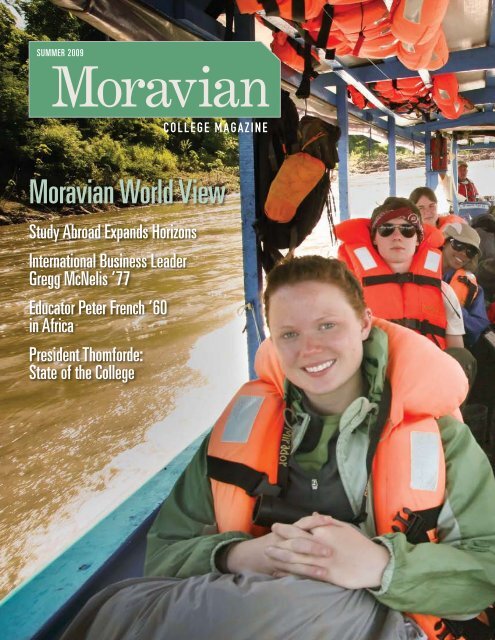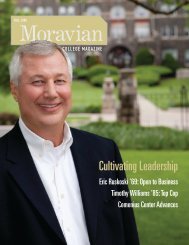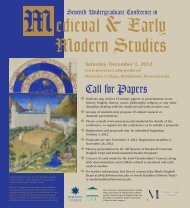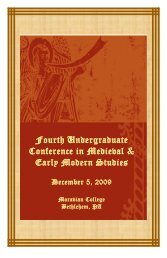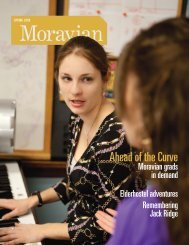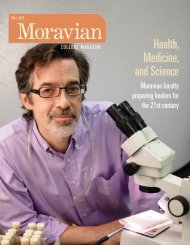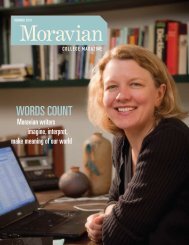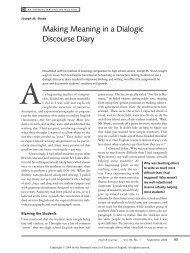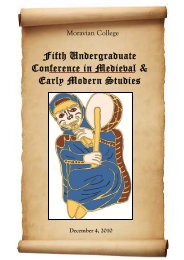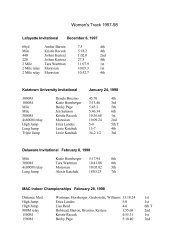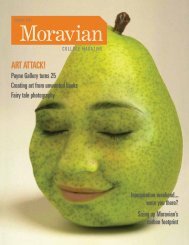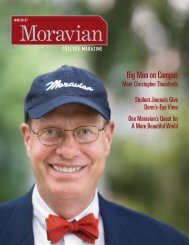Prelude: Change Your Life—Go Away - Moravian College
Prelude: Change Your Life—Go Away - Moravian College
Prelude: Change Your Life—Go Away - Moravian College
Create successful ePaper yourself
Turn your PDF publications into a flip-book with our unique Google optimized e-Paper software.
SUMMER 2009<br />
<strong>Moravian</strong><br />
<strong>Moravian</strong> World View<br />
Study Abroad Expands Horizons<br />
International Business Leader<br />
Gregg McNelis ’77<br />
Educator Peter French ’60<br />
in Africa<br />
President Thomforde:<br />
State of the <strong>College</strong>
<strong>Moravian</strong><br />
August’s incoming freshmen form fast<br />
friendships that often last a lifetime.
summer<br />
2009<br />
02 <strong>Prelude</strong>: <strong>Change</strong> <strong>Your</strong> Life—<br />
Go <strong>Away</strong><br />
Gordon Weil, dean of faculty, learned something<br />
about basketball, himself, and the value of<br />
human life during a college year abroad.<br />
10 Man of the World<br />
<strong>Moravian</strong>’s new director of international<br />
studies wants to broaden (y)our horizons.<br />
14 Cosmopolitan <strong>Moravian</strong>s<br />
Long before Greyhounds studied in Europe,<br />
the <strong>Moravian</strong> Church thought globally.<br />
16 Shipping News<br />
Gregg McNelis ’77, captain of the ’75-’76 Hall of<br />
Fame basketball team, practices discipline and<br />
diplomacy to win at international business.<br />
18 Letters from Africa<br />
Long-time educator Peter French ’60 returns to<br />
Ghana, a country that first intrigued him during<br />
his senior year at <strong>Moravian</strong>.<br />
04 Out & About<br />
20 Alumni News<br />
22 Greyhound Sports<br />
23 Transitions<br />
24 Orbis Pictus: Fresh Perspective<br />
See www.moravian.edu/magazine/extra for more photos<br />
from this issue’s stories.<br />
<strong>Moravian</strong> <strong>College</strong> Magazine : editor, Victoria Bingham;<br />
sports editor, Mark J. Fleming; web manager, Christie Jacobsen;<br />
director of publications, Susan Overath Woolley;<br />
director of public relations and marketing, Michael P. Wilson.<br />
Creative Direction: Jane Firor & Associates.<br />
Alumni Relations: director, Marsha Stiles, M.B.A. ’99;<br />
assistant director, Julia Gasdaska ’07; class notes assistant Patricia<br />
Murray Hanna ’82; student assistant, Stephanie Dorney ’11.<br />
Copyright 2009 by <strong>Moravian</strong> <strong>College</strong>. Photographs and artwork copyright<br />
by their respective creators or by <strong>Moravian</strong> <strong>College</strong>. All rights reserved.<br />
No portion of this publication may be reused or republished in any form<br />
without express written permission.<br />
Cover: Molly DuVall ’11 and Taylor Evans ’11 ride a canoe in Peru<br />
during the 2009 May-term tropical ecology class taught by Professor<br />
John Bevington. photo Story by John on Kish page IV 10.
p r e l u d e Stories from the <strong>Moravian</strong> community<br />
Courtesy of Gila Yudkin<br />
courtesy of Michelle guth<br />
photo by JASON BEVINGTON<br />
Photo by Sarabeth Brockley ’11<br />
Photo by Kelly Gallagher ’09<br />
2 MORAVIAN COLLEGE MAGAZINE SUMMER 2009
<strong>Change</strong> <strong>Your</strong> <strong>Life—Go</strong> <strong>Away</strong><br />
By Gordon Weil, vice president for academic affairs and dean of the faculty<br />
I was excited when I first heard about it. Sometime during my<br />
freshman year at Tulane University, I learned about the Junior Year<br />
Abroad program. Because I could only speak English, I set my sights<br />
on England. I talked to some friends and they decided to apply as<br />
well. By the time my junior year arrived, I was off to York University<br />
in York, England—a town surrounded by medieval walls.<br />
Although I left my girlfriend behind and she was not happy<br />
about that, it was transformative for me (and evidently not fatal to<br />
our relationship as we married a few years later and remain married<br />
to this day). I learned as much--probably more—outside the<br />
classroom than I did inside. Inside, I studied English literature with<br />
one of the foremost scholars of D. H. Lawrence. In an economics<br />
class, I was forced to confront mind-bending questions, such as<br />
“how do you value a human life”<br />
But it was my life outside the classroom that<br />
was the highlight of my year. I roomed with Adrian,<br />
a bloke from London, who taught me about music,<br />
poetry, India, England, and much more. I spent a<br />
few weekends with his family in Hampstead, and we<br />
kept in touch for many years afterward. The English were great at<br />
soccer, but not so much at basketball. So I can now truthfully claim<br />
to have been the starting point guard on my college team. (If you<br />
know me, this might come as a surprise.)<br />
I traveled around Great Britain on weekends to visit friends,<br />
and we toured the continent together over our breaks. And we did<br />
it, as they said back then, on “five dollars a day.”<br />
I learned I could negotiate cultures I didn’t fully understand. I<br />
learned I could communicate in countries where I didn’t speak the<br />
language. I learned what nationalism really meant. For a while, I<br />
“understood deep down” that America really was the best country,<br />
just as my English and Spanish friends felt deeply that their own<br />
country was the best. I learned about different educational systems,<br />
and how amazing it was that such a large proportion of Americans<br />
had the opportunity to go to college. And I came to appreciate what<br />
Hounds abroad 2009 (clockwise from top left): An English education class led by<br />
Professor Joe Shosh took students to Shakespearean sites in England in June. In<br />
July, students helped excavate Ramat Rachel in Israel, working with Professors<br />
Jason Radine and Deborah Appler. Over spring break, a group led by Professors<br />
Moeller, Keim, and Denton-Borhaug learned about colonialism and immigration<br />
along the U.S./Mexican border. During a May-term tropical ecology class in Peru,<br />
Molly DuVall ’11 studied with Prof. John Bevington. DuVall and Sarabeth Brockley ’10<br />
(center) were happy for the opportunity to do additional research with Dr. Bevington<br />
in Peru’s lowlands and cloud forests. Above: Dean Gordon Weil, c. 1969.<br />
a treat it was to study broadly like we do in the U.S., rather than<br />
have to specialize from day one at a university.<br />
Many years later, I would tell my young sons stories about my<br />
experiences in Europe that year. I cleaned them up appropriately,<br />
but they remained good stories. I guess I should have expected it<br />
when my oldest son informed my wife and me that he would be going<br />
to London his junior year. I don’t know his stories—these things<br />
don’t move from son to father as well as they go the other way. But<br />
I do know that he is now bilingual because of that year. He roomed<br />
with two guys from Spain, who convinced him to live there after<br />
he graduated. He lived and worked there for a couple of years, and<br />
met a wonderful young woman from Madrid. She is now to be our<br />
daughter-in-law, and I’m the one trying to learn Spanish!<br />
><br />
A few years later, our youngest son informed us he was going<br />
to Kenya for a semester in his junior year. He arranged to spend six<br />
weeks working with the Kenya Wildlife Service studying elephants.<br />
I remember when he called to tell us, “I’ll be in the bush for about<br />
six weeks, and will call when I return.” Seven weeks later, no phone<br />
call. We were just about to phone the program when he called:<br />
whew! Those six “lost” weeks led to his senior year thesis. Now he<br />
works for an animal preservation program in New Orleans, caring<br />
for lions, tigers, and other big cats.<br />
My point is that you never know what the outcome will be<br />
when you open yourself to new experiences. And studying abroad<br />
can be as much fun as it is educational. Today the world has<br />
become so interdependent that it is practically a must for all young<br />
people to have at least one intercultural experience. <strong>Moravian</strong> <strong>College</strong><br />
students are fortunate because they have so many opportunities<br />
to study abroad. I advise students and their parents to “go for it!<br />
It will be the time of your life, and you’ll never be the same.” And<br />
that’s just what college is all about. W<br />
This article first appeared in Globalyours, the newsletter of the <strong>Moravian</strong> <strong>College</strong> Office of International<br />
Studies. Naomi Gal, Comenius professor of language and literature, is the editor..<br />
<strong>Prelude</strong> features stories from the <strong>Moravian</strong> <strong>College</strong> community, told in the storyteller’s<br />
own words. Send ideas or submissions to vbingham@moravian.edu.<br />
SUMMER 2009 MORAVIAN COLLEGE MAGAZINE 3
out&ABOUT<br />
Student Research Gains National Attention<br />
PHOTO BY DIANE HUSIC<br />
Congressman Charles Dent and Sarabeth<br />
Brockley ’10 (above) recently discussed the<br />
role of research in reclaiming the Lehigh Gap<br />
Superfund site. Working with Professor Diane<br />
Husic, Brockley studied the plant sandwort as an<br />
indicator of conditions at the site.<br />
Decades of industrial pollution wreaked havoc on a section<br />
of the Lehigh Gap near Palmerton, Pa., leaving the once lush<br />
mountainside nearly barren. But over the last several years, the<br />
Superfund site has begun to grow more green, thanks to the<br />
efforts of many working to revitalize the area. The site has been<br />
the focus of several <strong>Moravian</strong> SOAR (Student Opportunities for<br />
Academic Research) projects, including the work of environmental<br />
science major Sarabeth Brockley ’10, who documented the<br />
presence of sandwort, a small wasteland plant that indicates the<br />
progress of the revegetation efforts.<br />
This spring, Brockley was invited to present her research<br />
“Analysis of Plant Succession at the Lehigh Gap—a Superfund<br />
Site Undergoing Restoration” at the Posters on the Hill session<br />
conducted by the Council on Undergraduate Research, held in<br />
Washington, D.C. “CUR received 447 proposals and only 60<br />
were selected, so this is an incredible honor,” said Professor<br />
Diane Husic, chair of the Department of Biological Sciences<br />
and Brockley’s mentor on the project.<br />
After the session, Brockley met with U.S. Representative<br />
Charles Dent (PA-15), his legislative assistant Collin Long, and<br />
Kate McMahon, an aide to Representative Paul E. Kanjorski<br />
(PA-11). “Speaking with legislators to promote your work and<br />
the importance of undergraduate research is thrilling,” she said.<br />
Professor Husic, Brockley, and Meredith Wright ’10 continue to<br />
work at the site this summer.<br />
HAPPENING . . .<br />
<br />
August 31<br />
First day of classes<br />
Fall term begins at<br />
<strong>Moravian</strong> <strong>College</strong><br />
PHOTO BY JOHN KISH IV<br />
October 22<br />
Machuca<br />
PROSSER AUDITORIUM,<br />
7:00 P.M. <br />
<br />
<br />
<br />
<br />
<br />
October 28<br />
2009 Janet A. Sipple<br />
Lectureship<br />
PROSSER AUDITORIUM<br />
<br />
<br />
<br />
<br />
<br />
4 MORAVIAN COLLEGE MAGAZINE SUMMER 2009
PHOTO BY JOHN KISH IV<br />
From Tree to Table<br />
Remember the enormous, old elm that grew on West Church Street<br />
near Main Hall In the fall of 2007, the <strong>College</strong> was forced to<br />
remove the 200-plus-year-old tree because disease made it hazardous<br />
to people, cars, and nearby buildings. Now a local woodworker<br />
is turning one of the elm’s incredible, 4-foot-wide slabs into an<br />
impressive table. “I admired that tree for years,” said Michael Kane,<br />
the Bethlehem artist who is making the table. “My mother’s home<br />
is just steps away from it, so I walked by its massive roots many<br />
times. The day it was cut down, I contacted the <strong>College</strong> and offered<br />
to make a table from some of the wood. I’m very happy to have the<br />
chance to work on this project.”<br />
Harold “Andy” Anderson, <strong>Moravian</strong>’s associate director of<br />
plant services, provided Kane with several slabs that had been<br />
roughly cut with a large band saw, preserving its gnarly exterior<br />
lines and knots while revealing its amazing interior grain. Kane<br />
will smooth the wood with a series of sandings, finishing with a<br />
super-fine 600-grit paper, followed by six applications of tung oil.<br />
When complete this fall, the 7-foot-long table will “live” in a Hurd<br />
Campus building, serving as a timeless tribute to <strong>Moravian</strong> <strong>College</strong>’s<br />
earliest days.<br />
Bethlehem artist Michael Kane is crafting a table from the old elm that once<br />
stood near Main Hall (inset). The wood was air-dried for more than a year before<br />
it was placed in a kiln to remove the remaining moisture. The finished table most<br />
likely will grace a building on Hurd Campus.<br />
<strong>Moravian</strong> through the Mail<br />
<br />
<br />
<br />
<br />
<br />
Edward C. Schultz<br />
<br />
<br />
<br />
<br />
<br />
<br />
<br />
<br />
<br />
SUMMER 2009 MORAVIAN COLLEGE MAGAZINE 5
out&ABOUT<br />
PHOTO BY MITCH MANDEL<br />
Roberto’s Spanish Lessons<br />
MICHAEL WILSON (2)<br />
At Roberto Clemente Charter School last spring,<br />
<strong>Moravian</strong> Spanish language students read stories<br />
they had written in Spanish for a class of sixthgraders<br />
(left) who speak the language fluently.<br />
Professor Silvia Mandler (above, left) arranged the<br />
visit to develop her class’s writing, reading, and<br />
conversational skills.<br />
A group of Spanish 110 students taught by Silvia Mandler, visiting instructor of Spanish,<br />
took their language lessons off campus and into the gymnasium of Roberto Clemente Charter<br />
School in Allentown last spring. Groups of Clemente sixth-graders (most of whom are fluent<br />
in Spanish) gathered round to hear <strong>Moravian</strong> students read stories they had written for the<br />
younger students in Spanish.<br />
Any initial awkwardness quickly disappeared as the sixth-graders listened, nodded, and<br />
applauded with appreciation. Finger puppets made by the <strong>Moravian</strong> students helped bring the<br />
story characters alive, eliciting comments and questions from the 12-year-olds. A story about<br />
a boy who lost his dog prompted one sixth-grader to share his own experience. Others were<br />
simply excited to have the attention of college students and curious about their school, asking,<br />
“Where is <strong>Moravian</strong>” “What sports do you have” “Can you learn to be a doctor there”<br />
“It was a good experience for our students, too,” said Professor Mandler. “The writing<br />
helps reinforce the grammar they learned in previous years, and many of them will go on to<br />
teach students who speak Spanish at home.”<br />
HAPPENING . . .<br />
November 17<br />
Sustainability Expo<br />
HAUPERT UNION BUILDING,<br />
<br />
<br />
<br />
<br />
November 19<br />
Der Untergang<br />
(Downfall)<br />
PROSSER AUDITORIUM,<br />
7:00 P.M.<br />
<br />
<br />
PHOTO BY JOHN KISH IV<br />
December 4-6, 11-13<br />
Christmas Vespers Services<br />
CENTRAL MORAVIAN CHURCH<br />
<br />
<br />
<br />
<br />
6 MORAVIAN COLLEGE MAGAZINE SUMMER 2009
How to Succeed on Broadway<br />
Cast members of In<br />
the Heights (above)<br />
met with <strong>Moravian</strong><br />
management students<br />
to discuss the business<br />
side of Broadway.<br />
Behind the fabulous storylines, costumes,<br />
and music of Broadway is a business in<br />
which producers and consumers play leading<br />
roles. The interplay between the two<br />
determines whether a production will be a<br />
rousing success or a spectacular flop.<br />
In April, <strong>Moravian</strong> business management<br />
professor Santo D. Marabella<br />
introduced twenty-five students to “The<br />
Business Side of Broadway” through an<br />
excursion to the Tony Award-winning musical<br />
In the Heights. Students met with the<br />
musical’s marketing director, tour manager,<br />
company manager, and cast members before<br />
and after the performance, gleaning<br />
insights about how to succeed in<br />
the business of entertainment.<br />
“In the Heights was a good<br />
model because it was one of the few<br />
recent Broadway productions that<br />
paid off its investors<br />
within its first<br />
year,” said Professor<br />
Marabella. “Yet it<br />
almost didn’t happen<br />
because producing<br />
a play, especially a<br />
musical, is such a<br />
risk.”<br />
Accessibility was<br />
key to the success<br />
of In the Heights.<br />
“It was one of the<br />
PHOTO BY JOAN MARCUS<br />
first Latino-driven<br />
musicals,” he explained, “and Broadway as<br />
a whole has been making it easier for more<br />
people to attend by offering reduced ticket<br />
prices and free admission for children.<br />
“Reputation also goes a long way<br />
in attracting customers—and investors<br />
are customers, really. If a company has<br />
produced a previous Tony winner, like this<br />
one [The Producing Office] did, satisfied<br />
customers spread the word.” Professor<br />
Marabella first offered “The Business Side<br />
of Broadway” field experience in 1993;<br />
the most recent trip was part of his new<br />
class, “Arts and Entertainment Production<br />
Management.”<br />
MORAVIANBOOKSHELF<br />
For scholars, peer recognition is perhaps<br />
the highest form of praise. <strong>Moravian</strong><br />
emeritus professor of political philosophy<br />
Hwa Yol Jung’s body of work has inspired a<br />
festschrift, a volume of essays by<br />
scholars from several disciplines.<br />
Edited by Jin W. Park, associate<br />
professor of philosophy and<br />
religion at American University,<br />
Comparative Political Theory<br />
and Cross-Cultural Philosophy:<br />
Essays in Honor of Hwa Yol Jung<br />
highlights Professor Jung’s contributions<br />
regarding globalization,<br />
ecology, East-West comparative<br />
philosophy, literature, and more. Available<br />
at Amazon.com.<br />
Free to Be—Stories of Hope and Survival,<br />
the latest book project by Naomi<br />
Gal, Comenius professor of literature and<br />
languages, is a collection of<br />
stories written by survivors<br />
of domestic abuse who found<br />
their voice and a new life<br />
through Turning Point of the<br />
Lehigh Valley. Professor Gal<br />
led a writers’ workshop from<br />
which the stories were drawn.<br />
The <strong>Moravian</strong> chapter of<br />
Alpha Sigma Alpha sorority helped raise<br />
funds and contributed stories, poems, and<br />
editing to support the project. To purchase<br />
the book, go to Amazon.com; all proceeds<br />
benefit Turning Point of the Lehigh Valley.<br />
A second edition of The Practical<br />
Researcher—a Student Guide<br />
to Conducting Psychological<br />
Research, the highly praised text<br />
by Dana S. Dunn, professor of<br />
psychology, has been published.<br />
The new edition features helpful<br />
decision trees at the beginning of<br />
each chapter, practical tools and<br />
tips, updated information on ethical considerations,<br />
additional references, and much<br />
more. The Practical Researcher has been<br />
lauded for its student-friendly style and<br />
step-by-step approach for teaching students<br />
how to conduct quality research and analyze<br />
results. Available from Wiley-Blackwell<br />
at www.wiley.com/wiley-blackwell.<br />
SUMMER 2009 MORAVIAN COLLEGE MAGAZINE 7
out&ABOUT<br />
MCQ&AWITH...<br />
President Thomforde<br />
Christopher Thomforde takes stock of the<br />
state of <strong>Moravian</strong> <strong>College</strong> at the beginning<br />
of his fourth year as its president.<br />
We’ve all read about the impact of the economic<br />
crisis on higher education, and have<br />
felt its effects in our own lives. How has<br />
<strong>Moravian</strong> <strong>College</strong> been affected<br />
The impact of the economic crisis on<br />
colleges and universities has been manifold.<br />
It has affected the ability of parents and<br />
students to pay for education, so now we<br />
must ask, “How can we cover the costs of<br />
providing a quality education and still be<br />
affordable” We do not want to go back to<br />
an early twentieth-century model, where<br />
only the wealthy can afford college.<br />
Many colleges have seen their endowments<br />
fall tremendously over the last year.<br />
Fortunately, <strong>Moravian</strong> is not absolutely<br />
dependent on its endowment to operate—<br />
we depend more on tuition. But losing 25<br />
to 30 percent of our endowment funds<br />
does impact scholarships, some endowed<br />
academic positions and programs, and<br />
general operations. Add to this the rising<br />
costs of health care and goods and services,<br />
and it becomes clear that the situation is<br />
extremely challenging.<br />
We face the same pressures that American<br />
families face—multiplied by a great<br />
factor. Instead of caring for a couple of<br />
children and a mortgage, we have 1,600<br />
children and many buildings. The fundamental<br />
questions for private colleges are:<br />
how do we act as good stewards to protect<br />
what we have And, how do we best use<br />
those resources to benefit our students Access<br />
and affordability are primary concerns.<br />
You mention access, which relates to one<br />
of the key initiatives of our recent strategic<br />
plan (“discover and develop a more diverse<br />
student body”). How will economic conditions<br />
affect our ability to achieve this and<br />
other strategic initiatives<br />
The trustees, senior faculty and staff, and<br />
I agree that we need to continue to move<br />
forward with our strategic plan while also,<br />
><br />
paradoxically, finding ways to reduce costs.<br />
<strong>Moravian</strong> <strong>College</strong> came into this crisis in a<br />
strong position—our endowment, financial<br />
management, enrollment, and the quality of<br />
our people are strong. So let’s keep moving<br />
ahead, but let’s move strategically. You don’t<br />
want to lose momentum, and costs are not<br />
going to go down if we wait five years.<br />
Over the past year, we’ve made important<br />
progress on many of our strategic<br />
initiatives. Of all the things we can do,<br />
we want to keep moving ahead with the<br />
first—making sure that the <strong>College</strong> is<br />
accessible to quality students of all backgrounds.<br />
Bernie Story [vice president for<br />
enrollment] and his staff have done an<br />
excellent job with this for the coming year.<br />
Twenty-eight percent of the new freshman<br />
class is in the top 10 percent of their high<br />
8 MORAVIAN COLLEGE MAGAZINE SUMMER 2009
PHOTO BY JOHN KISH IV<br />
school graduating class. We also met our<br />
target numbers for enrollment, and about<br />
18 percent of our freshman class belongs to<br />
under-represented groups. So we have made<br />
a big leap forward with our first strategic<br />
initiative. We’ve also met with a financial<br />
aid consultant to determine how to best use<br />
our financial aid resources to advance this<br />
important initiative.<br />
With regard to our second initiative,<br />
recruiting and hiring faculty, we have filled<br />
some positions, and we will add new ones<br />
as more resources become available. Other<br />
strategic advancements over the past year<br />
include strengthening staff, particularly in<br />
counseling and student life [initiative three];<br />
completing the Hurd Integrated Living and<br />
Learning facility, making plans for expanding<br />
our science facilities, and creating an<br />
extensive land use master plan [initiative<br />
four]; assessing the use of our technological<br />
resources [initiative five]; expanding the<br />
offerings of the Comenius Center with new<br />
programs in nursing, human resources, and<br />
education [initiative six]; and beginning a<br />
comprehensive campaign to raise funds to<br />
support these initiatives [initiative seven].<br />
We have assembled a campaign cabinet,<br />
chaired by board member Parry Miller ’66,<br />
along with Mrs. Priscilla Hurd and DeLight<br />
Breidegam as honorary chairs. The response<br />
to the campaign has been very encouraging.<br />
What should be our focus in the year ahead<br />
This recession appears to be unlike<br />
earlier ones we’ve lived through. There are<br />
fundamental disruptions to the economy<br />
and how it is organized. It will affect how<br />
colleges operate in the future, what students<br />
will expect from colleges, and what parents<br />
and students will be willing and able to pay<br />
for education.<br />
As a result, I believe one of our most<br />
important activities for the coming year<br />
will be sharpening our vision for the future<br />
of <strong>Moravian</strong>. My hope is that by fall,<br />
we will have an assessment of what our<br />
financial resources will be over the next<br />
several years. From November to March,<br />
we will have a period of creative visioning<br />
by board members, faculty, administrators,<br />
staff, alumni—everyone involved:<br />
given our resources, our strategic plan, and<br />
<strong>Moravian</strong>’s heritage, what can and should<br />
we do going forward What will the local<br />
community—the Lehigh Valley, eastern<br />
Pennsylvania, and New Jersey—need from<br />
us in the future Our alumni can be very<br />
helpful because they already are out there,<br />
working as teachers, lawyers, doctors, and<br />
dentists. They can tell us how to strengthen<br />
the programs our community needs. After<br />
this period of visioning, we will test some of<br />
the ideas to see which fit best.<br />
Just like a family faced with difficult<br />
times, we don’t want to stay indoors with<br />
the shades pulled down. Instead we say,<br />
what can we afford to do now that is exciting<br />
and still indicative of who we are as a<br />
family How can we better serve our shifting<br />
demographics and strengthen our capacity<br />
to educate, while remaining financially<br />
viable We already are doing these things<br />
well—thanks to the hard work of the entire<br />
<strong>Moravian</strong> community—but now is the time<br />
to pause and consider how best to accomplish<br />
our mission during our next 25 years.<br />
Czech Honor<br />
<br />
<br />
<br />
<br />
<br />
<br />
<br />
<br />
<br />
<br />
PHOTO BY JOHN KISH IV<br />
SUMMER 2009 MORAVIAN COLLEGE MAGAZINE 9
Man of the World<br />
Kerry Sethi, new director of international studies, explains how study<br />
abroad could change the world—from the inside out<br />
photo by John kish iv<br />
Man of the World<br />
erry Sethi, director of international studies,<br />
is a man on a mission. When he isn’t<br />
busy filling out immigration forms, counseling<br />
anxious students across the Atlantic,<br />
or explaining study abroad possibilities<br />
to parents, he’s looking for ways to add<br />
to his workload. Sethi wants the number<br />
of <strong>Moravian</strong> students studying abroad to<br />
double or even triple within the next few<br />
years. And he says he won’t be satisfied<br />
until every student “who dreams of studying<br />
abroad has the opportunity to do so,”<br />
even—or perhaps especially—if the location<br />
is out of the ordinary.<br />
He’s well on the way. Since he became<br />
director of the program last September, interest<br />
in study abroad has increased among<br />
students and faculty members alike. New<br />
faculty-led programs have been offered to<br />
Mexico, Israel, and Hong Kong; overall<br />
10 MORAVIAN COLLEGE MAGAZINE SUMMER 2009
student participation has increased; and<br />
2008-09 “probably was the best in years<br />
for the International Club,” which grew in<br />
membership and visibility.<br />
Sethi’s world view and ease with people<br />
of all cultures come naturally, it seems. The<br />
son of a physician and a medical researcher<br />
(both from India), Sethi was born in Ireland<br />
when his father was a hospital resident in<br />
rural County Kerry. “The nuns at the hospital<br />
wanted to name me Patrick because<br />
they believed I was the first foreigner born<br />
there,” he said, with a laugh. “Instead, my<br />
parents chose Kerry, after the county.” The<br />
family moved often as his parents acquired<br />
and applied their medical expertise in<br />
England, Canada, the Caribbean, and India.<br />
They settled in the United States when<br />
Sethi was in high school. As a grad student<br />
majoring in public administration at the<br />
University of Maine, he was offered a job in<br />
the Canadian-American Center, working on<br />
its newsletter and multicultural programming,<br />
and advising students: “I really liked<br />
it. It tied into my studies, and I enjoyed<br />
working with the students.” Twenty-some<br />
years later, he employs empathy, diplomacy,<br />
and subtle persuasion to help students and<br />
parents broaden their own world view<br />
through study abroad.<br />
Recently, we talked with Kerry Sethi to<br />
learn more about the International Studies<br />
Program at <strong>Moravian</strong> <strong>College</strong> and his vision<br />
for its future.<br />
What does your work at <strong>Moravian</strong> involve<br />
With assistance from Gloria Guth<br />
[secretary, international studies] and Naomi<br />
Gal [Comenius professor of language and<br />
literature], I help our international students<br />
with immigration documentation, cultural<br />
adjustments, homesickness, housing issues;<br />
getting insurance and Social Security cards<br />
. . . some of it is tedious, but it’s all very<br />
important. We presently have 28 of them,<br />
and most are enrolled for all four years.<br />
I also work with students who want to<br />
study abroad for a semester or a year. We<br />
meet at least three to four times before they<br />
leave, and I explain the process to them<br />
and their parents. When they are at their<br />
destination, I remain in contact through<br />
e-mail, phone, and care packages. If something<br />
goes wrong, I work with them to find<br />
a solution.<br />
What can go wrong<br />
Sometimes a class is not the right fit;<br />
our office helps keep the student and their<br />
parents calm. We work with faculty members<br />
and the deans on curriculum changes,<br />
if necessary. When a student protest shut<br />
down a university in France, for instance,<br />
our students e-mailed and asked, “What do<br />
I do I have a class to take—how will I get<br />
credit” We went back and forth to find a<br />
solution. There’s always something going<br />
on, which makes it exciting. I try to look at<br />
everything as if I was the parent—I want<br />
parents to feel comfortable.<br />
Why is it important for students to study<br />
abroad What are the benefits<br />
It has a dramatic impact—it’s much<br />
more than an isolated experience; it stays<br />
with you for the rest of your life. Studying<br />
abroad gives students a different perspective<br />
of the world, their country, and themselves.<br />
When you are away from home and experiencing<br />
new things, managing your life can<br />
be a challenge. It can push<br />
you to the limit of what<br />
you can handle, but you<br />
develop self-confidence.<br />
It also can challenge your<br />
belief system—hearing<br />
news coverage of your<br />
country somewhere else,<br />
for instance, makes you<br />
think more critically about<br />
its role in the world. When<br />
you return, you want to<br />
share and discuss your<br />
observations with others.<br />
And you want to become<br />
more involved.<br />
London Calling<br />
For future English teachers, it doesn’t<br />
get any better. This summer, a group<br />
of <strong>Moravian</strong> grad students will revel<br />
in Shakespeare’s “Romeo and Juliet”<br />
performed at London’s Globe Theatre;<br />
they’ll consider the experiential<br />
philosophy of British educator John<br />
Dixon; and they’ll visit the Tower of<br />
London, Shakespeare’s birthplace, and<br />
more—all within ten days. “The city<br />
of London will be their classroom,”<br />
said Joe Shosh, leader of “English<br />
Education in London, Oxford, and<br />
Stratford-on-Avon” and director of<br />
the M.Ed. Curriculum and Instruction<br />
Program. “It’s an intense learning<br />
experience, and we go from breakfast<br />
until we can’t walk anymore.”<br />
Authentic experiences like these<br />
become resources for lifelong learning<br />
and teaching.<br />
SUMMER 2009 MORAVIAN COLLEGE MAGAZINE 11
Man of the World<br />
and opinions, which is terrific. Faculty<br />
members are invigorated by going abroad,<br />
too—they come back with a new frame of<br />
reference to use in class.<br />
The Japanese Connection<br />
<strong>Moravian</strong> students don’t always board planes to experience other cultures: sometimes,<br />
they simply open their door, as many did in March, when students from Japan’s Ohtani<br />
University visited <strong>Moravian</strong> <strong>College</strong>. Every year, Ohtani education students come to<br />
<strong>Moravian</strong> as part of an exchange between Bethlehem and its Japanese sister city,<br />
Tondabayashi. For three weeks, Ohtani students live on campus, attend classes, and mix<br />
with <strong>Moravian</strong> students over meals, at parties, and on field trips to New York City and<br />
other regional attractions. Members of the <strong>College</strong>’s International Club help organize<br />
events and act as hosts. “So many <strong>Moravian</strong> students volunteered to host this year that<br />
the Ohtani students offered to change rooms just to give more of our students a chance<br />
to room with them,” said Sethi.<br />
The Bethlehem-Tondabayashi Sister City Commission honored the students with a<br />
reception held in the Japanese tea garden next to the Bethlehem Public Library. The<br />
garden was a gift to the city of Bethlehem from the city of Tondabayashi.<br />
Above: Ohtani University students were happy to<br />
greet greyhounds all around campus during their<br />
visit to <strong>Moravian</strong> in April.<br />
It also makes students more employable<br />
in our increasingly globally-connected<br />
world. If you are applying for a job with a<br />
company that has a concern in Germany,<br />
for instance, you have a big advantage if<br />
you’ve already had some experience with<br />
that culture.<br />
How does having an international studies<br />
program benefit the <strong>College</strong><br />
It raises our profile, and gives prospective<br />
students another reason to choose<br />
<strong>Moravian</strong>. And the more international<br />
students we have, the more our students are<br />
exposed to people of different backgrounds<br />
photo by john kish iv<br />
What changes did you make to the program<br />
this year<br />
Previously our programs were limited—<br />
probably because most students limited<br />
themselves to certain destinations, such<br />
as England, Ireland, France, Spain, and<br />
Germany. Now that’s changing. We have a<br />
student in Argentina, another in Italy, one<br />
in Korea, two going to South Africa, one<br />
in Turkey—<strong>Moravian</strong> students are starting<br />
to look at different locations, and we’re<br />
encouraging that.<br />
I tell students, “If you can prove that a<br />
course is accredited and has academic rigor,<br />
and that it can contribute to your degree,<br />
then yes, we can make it happen.”<br />
We’re encouraging faculty members in<br />
all academic departments to work with us,<br />
too. If a student wants to study music in<br />
an unusual location, for instance, I’ll say<br />
let’s figure out how to do that. If a full year<br />
of study abroad is not possible, maybe a<br />
semester or summer term would work. The<br />
faculty members have been wonderful.<br />
What’s your vision for the program over the<br />
long term<br />
This year, twenty students per semester<br />
went abroad. I’d like to increase that to<br />
fifty per semester. I’d also like to double<br />
our student exchanges—to start a few more<br />
programs beyond the ones we have with<br />
Germany and the Czech Republic. Our<br />
program is not yet at the level of some of<br />
the large, local colleges, but I have no doubt<br />
we can get there soon, especially with the<br />
growing interest among faculty members<br />
and first-year students.<br />
Is there a study program you would like to<br />
lead yourself—a dream destination you’d like<br />
to offer<br />
I’d really like to take a group to Egypt.<br />
With its history, location, and sites, it is one<br />
of the most amazing places in the world. W<br />
12 MORAVIAN COLLEGE MAGAZINE SUMMER 2009
photos by john kish iv<br />
Hands Across the Water<br />
Beyond the classroom, <strong>Moravian</strong> reaches out<br />
Imagine having a family member who suffers from a life-threatening<br />
illness, and the only health care provider within miles is a 15-year-old<br />
nurse with a 7th-grade education. Such a scenario is not unusual in<br />
Mozambique. An East African country of 20 million people, Mozambique<br />
has just 4,000 nurses, who have various levels of nursing education.<br />
Malaria, HIV/AIDS, tuberculosis, hepatitis, and typhoid fever are<br />
prevalent, cutting life expectancy to just 42 years.<br />
To help improve these bleak conditions, St. Luke’s School of Nursing<br />
at <strong>Moravian</strong> <strong>College</strong> (SON/<strong>Moravian</strong>) faculty members have entered a<br />
twinning partnership to strengthen the nursing force of Mozambique.<br />
The partnership is fully funded by the President’s Emergency Plan for<br />
AIDS Relief, a $150,000 grant from the American International Health<br />
Alliance. In early January, professors Lori Hoffman (who initiated the<br />
partnership grant process), Michelle August-Brady, and Maria Schantz<br />
visited Mozambique to assess conditions. In April, representatives of<br />
the Associaçao Nacional dos Enfermeiros de Moçambique (National<br />
Association of Nurses of Mozambique) came to <strong>Moravian</strong> <strong>College</strong> to<br />
observe, plan, and share their unique challenges and perspectives. The<br />
partnership is expected to benefit not only the nurses and people of<br />
Mozambique, but also faculty members, students, and other members of<br />
the <strong>Moravian</strong> community. As Mozambican nurses learn about fundraising<br />
and marketing, <strong>Moravian</strong>s become more familiar with tropical diseases<br />
and the local, hands-on healing methods of another culture.<br />
Gary Olson, professor of political science,<br />
collaborates with a student on a research project.<br />
photo by john kish iv<br />
Representatives of the National Association of Nurses of Mozambique and SON/<strong>Moravian</strong><br />
faculty members (from left): Matilde Basilio; Olga Novela; Maria Schantz, assistant professor<br />
of nursing; Lida Monjane; Michelle August-Brady, associate professor of nursing; Romao<br />
Xavier; and Lori M. Hoffman, associate professor of nursing. At an April presentation,<br />
panelists discussed the state of Mozambican health care (depicted in a Mozambican tapestry)<br />
and how to strengthen its nursing force. A musical celebration followed.<br />
SUMMER 2009 MORAVIAN COLLEGE MAGAZINE 13
Cosmopolitan <strong>Moravian</strong>s<br />
“Community” meant the world to early <strong>Moravian</strong>s.<br />
By Paul Peucker<br />
“<br />
We are citizens of the world,”<br />
<strong>Moravian</strong> leader Count Nicholas<br />
von Zinzendorf said in 1747,<br />
paraphrasing the classical Greek<br />
philosopher Diogenes who, when asked<br />
where he came from, replied, “I am a citizen<br />
of the world.”<br />
“We are not at home anywhere,” continued<br />
Zinzendorf. “We build one nice community<br />
after another, one beautiful house<br />
after another, so that people can see we are<br />
pilgrims who are not attached to one place.<br />
. . . We are citizens of<br />
the entire world.”<br />
By the time<br />
Zinzendorf spoke<br />
these words, <strong>Moravian</strong>s<br />
had spread from<br />
their original community<br />
of Herrnhut<br />
in Saxony to many<br />
places throughout<br />
the world. They had<br />
established <strong>Moravian</strong><br />
communities not only<br />
in different parts of<br />
Europe, but also in<br />
the woods of Pennsylvania,<br />
where they founded Bethlehem;<br />
they worked among the North American<br />
Indians, the Inuit of Greenland, the Khoikhoi<br />
at the southern Cape of Africa, and<br />
the slaves of the Caribbean. Although many<br />
founders of Herrnhut came from Moravia<br />
in what is today called the Czech Republic,<br />
people from many other places had joined<br />
them. Eighteenth-century <strong>Moravian</strong>s were<br />
truly a multinational group. In 1750 Bethlehem,<br />
you could find people from Germany,<br />
Britain, Scandinavia, Sri Lanka, and Africa,<br />
as well as American Indians.<br />
Although the <strong>Moravian</strong>s’ lingua franca<br />
was German in most cases, <strong>Moravian</strong>s were<br />
proud of the variety of languages spoken in<br />
their communities, and on several occasions<br />
they sang hymns in all of the languages<br />
found in their congregations. On September<br />
4, 1745, Bethlehem <strong>Moravian</strong>s simultaneously<br />
sang a hymn in eighteen different<br />
languages. To them, this “polyglot singing”<br />
represented an end to the Babylonian confusion<br />
of languages described in the Bible.<br />
During the eighteenth century, individual<br />
identities usually were defined by the<br />
region where a person was<br />
born or by the language he<br />
or she spoke. Strong national<br />
identities connected<br />
to a nation-state did not<br />
develop until much later.<br />
<strong>Moravian</strong>s were aware of<br />
their varied backgrounds,<br />
but they considered all<br />
new members to be brothers<br />
and sisters. They immediately<br />
took on a new,<br />
<strong>Moravian</strong> identity—an<br />
identity carefully crafted<br />
by uniform dress, architecture,<br />
and customs and worship<br />
practices that were very much the same<br />
throughout <strong>Moravian</strong> congregations.<br />
The <strong>Moravian</strong> Historical Society in<br />
Nazareth, Pa., has an intriguing image from<br />
1758 depicting all of the different <strong>Moravian</strong><br />
communities at the time combined in<br />
one landscape. (See top of page 15.) At the<br />
center of the image is the original <strong>Moravian</strong><br />
community, Herrnhut. Just below Herrnhut<br />
is Bethlehem, situated on a river flowing<br />
into a small bay with Caribbean houses and<br />
a <strong>Moravian</strong> ship. On the horizon are the<br />
houses of the <strong>Moravian</strong> Inuit in Greenland.<br />
It is an imagined landscape, but this is how<br />
14 MORAVIAN COLLEGE MAGAZINE SUMMER 2009
photos by john kish iv; courtesy moravian historical society<br />
eighteenth-century <strong>Moravian</strong>s envisioned<br />
their world: they identified as one worldwide<br />
community, no matter how great the<br />
physical distances between them.<br />
When German philosophers such as<br />
Wieland, Lessing, and Kant began referring<br />
to themselves as citizens of the world during<br />
the second half of the eighteenth century,<br />
<strong>Moravian</strong>s had long practiced their cosmopolitan<br />
ideas. Because they perceived themselves<br />
as a worldwide fellowship, Bethlehem<br />
<strong>Moravian</strong>s did not hesitate to send financial<br />
support to a German congregation after<br />
a fire destroyed their community in 1792.<br />
Likewise, Bethlehem <strong>Moravian</strong>s received<br />
financial contributions from <strong>Moravian</strong>s in,<br />
for example, the Netherlands and Russia<br />
when Central Church was being constructed.<br />
All major decisions were made by the<br />
central leadership of the church in Germany.<br />
By the mid-nineteenth century, <strong>Moravian</strong>s<br />
had become aware of the shortcomings<br />
of a centralized leadership. American<br />
<strong>Moravian</strong>s did not believe the leaders in<br />
Europe fully understood American churches.<br />
In 1857, <strong>Moravian</strong>s reorganized and allowed<br />
self-governance by the <strong>Moravian</strong> Church in<br />
America and in Great Britain. At the same<br />
time, <strong>Moravian</strong>s began preparing for greater<br />
independence of their mission churches.<br />
Although few <strong>Moravian</strong>s today would<br />
characterize themselves as citizens of the<br />
world in the same manner Count Nicholas<br />
did 250 years ago, <strong>Moravian</strong>s still feel<br />
strong ties with fellow <strong>Moravian</strong>s in other<br />
parts of the world. This summer representatives<br />
from all parts of the <strong>Moravian</strong> world<br />
will gather in England to discuss matters<br />
pertaining to the worldwide <strong>Moravian</strong><br />
Church. This so-called Unity Synod meets<br />
every seven years. The Northern Province<br />
will be represented, among others, by Rev.<br />
Otto Dreydoppel, professor of church history<br />
at <strong>Moravian</strong> Theological Seminary. W<br />
Paul Peucker is archivist of the <strong>Moravian</strong><br />
Archives in Bethlehem; see www.<br />
moravianchurcharchives.org.<br />
Top: This international settlement scene<br />
(unknown artist, 1758) depicts the<br />
first <strong>Moravian</strong> community, Herrnhut,<br />
surrounded by <strong>Moravian</strong> establishments<br />
on six continents. The back of the Single<br />
Brethren’s’ House in Bethlehem can<br />
be seen in the foreground and detail<br />
image on p.14. This pen and ink drawing<br />
and hundreds of <strong>Moravian</strong> mission<br />
artifacts are housed at the <strong>Moravian</strong><br />
Historical Society in Nazareth, Pa.,<br />
www.moravianhistoricalsociety.org.<br />
<strong>Moravian</strong> mission artifacts from top right,<br />
clockwise: walrus tusk cribbage board,<br />
Alaska, 1912-14; decorated gourd bowl,<br />
Caribbean Islands, c. 1900; 36-inch-tall<br />
folding organ used by Rev. Samuel and<br />
Eva Allen in Jamaica missions, Bilhorn<br />
Bros., U.S.A., c. 1900; Pende dance mask,<br />
South Africa (Mbuya), c. 1860.<br />
SUMMER 2009 MORAVIAN COLLEGE MAGAZINE 15
16 MORAVIAN COLLEGE MAGAZINE SUMMER 2009
Shipping News<br />
A former basketball star relies on discipline, integrity, and<br />
teamwork to rise to the top in international business.<br />
Gregg McNelis ’77 makes smart moves<br />
for a living.<br />
As senior executive vice-president<br />
and chief operating officer of TBS International<br />
Ltd., McNelis advises business clients<br />
and partners about the most efficient,<br />
effective way to ship their valuable cargo to<br />
markets worldwide. In a month’s time, he<br />
often conducts business on several different<br />
continents, one week over a plate of<br />
feijaoda in Brazil, the next over kimchee<br />
in Korea. He pauses only long enough to<br />
contemplate his next move, it seems.<br />
For the former basketball team captain,<br />
the fast-paced, high-stakes arena of international<br />
business is challenging, even exhausting<br />
at times, but exciting and very rewarding.<br />
“My work allows me to perform and<br />
compete with people from many cultures—<br />
the Chinese, Dutch, Greeks—anyone in the<br />
world engaged in commerce,” he says. “You<br />
compete with others whom you respect and<br />
like. And if you perform well, with honor<br />
and integrity, you will prevail—even when<br />
times become tough.”<br />
A founding partner in TBS (1993), Mc-<br />
Nelis got his start in shipping as a broker,<br />
shortly after he graduated from <strong>Moravian</strong><br />
with a dual degree in business and English.<br />
In the 1972-73 season, former <strong>Moravian</strong><br />
men’s basketball coach Ted Zawacki<br />
recruited him to play for the Greyhounds,<br />
and the 1975-76 team went on to tie for<br />
the MAC Southern Division Southwest<br />
Championship. The team was inducted<br />
into the <strong>Moravian</strong> <strong>College</strong> Athletics Hall of<br />
Fame in fall 2008. McNelis credits Coach<br />
Zawacki and Professors Robert Burcaw<br />
(English), George Schneller (management),<br />
John Grencer (economics) and others for<br />
instilling discipline and confidence.<br />
“Coming to <strong>Moravian</strong> for college was<br />
one of the best things I ever did,” he says.<br />
“The discipline you learn in your sport, together<br />
with the knowledge gained in the classroom,<br />
can be tremendous assets in business.”<br />
Having a command of language has<br />
been critical for building relationships with<br />
clients and partners. Speaking even a few<br />
sentences in Chinese, for instance, goes a<br />
long way toward creating the trust needed<br />
to make deals, he says.<br />
In recent months, TBS has taken a large<br />
but calculated risk by launching the first<br />
two in a series of new cargo vessels. M.V.<br />
Rockaway Belle, launched in November, was<br />
named by TBS president and chief executive<br />
officer Joseph Royce to honor the 911<br />
heroes from Rockaway Beach,<br />
his home neighborhood in<br />
New York City. With a $35<br />
million price tag, Rockaway<br />
Belle represents a significant<br />
investment, but McNelis says<br />
its strategic advantages make<br />
the cost well worthwhile.<br />
“Rockaway Belle will allow<br />
us to out-service our competition,”<br />
he says. “It can be<br />
used for many kinds of cargo,<br />
so we will gain higher returns<br />
than we could from a less sophisticated<br />
vessel.” A TBS team<br />
with commercial, operational, and<br />
technical expertise designed the ship, tapping<br />
knowledge gained over 30 years of serving<br />
customers worldwide.<br />
“Launching a ship like this is like being<br />
in the NCAA Final Four,” he adds. “I’m<br />
very excited and proud to play a part.” TBS<br />
launched its second new ship—M.V. Dakota<br />
Belle—from Nantong, China, on May 25. W<br />
Gregg McNelis lives in Goldens Bridge, N.Y., with his wife,<br />
Susanne. For more information,see www.tbsship.com.<br />
Gregg McNelis ’77 (top), chief operating<br />
officer of TBS International Ltd., helps lead<br />
a team that recently launched the M.V.<br />
Rockaway Belle (facing page), a new ship<br />
named in honor of 911 heroes. Above:<br />
McNelis (circled) learned the value of<br />
persistence and teamwork while playing<br />
for <strong>Moravian</strong>’s Hall of Fame 1975-76 men’s<br />
basketball team.<br />
SUMMER 2009 MORAVIAN COLLEGE MAGAZINE 17
Letters from<br />
Africa<br />
Educator Peter French ’60 returns to<br />
Ghana—a country that first captivated him<br />
nearly fifty years ago.<br />
October 26, 2008<br />
Dear Colleagues and Friends,<br />
Retirement has proven to be a time to relax and contemplate new ways to<br />
remain active. Now, an opportunity has crystallized to engage the mind and<br />
apply practical skills developed over the years.<br />
I have accepted an invitation to serve as consultant to the Vice-Chancellor<br />
of the University of Ghana in Accra. The assignment is to evaluate the<br />
university’s academic practices, policies, and procedures and make recommendations<br />
for improvement. The university is committed to renewal and<br />
growth, as evidenced by the recent appointment of retired U.N. Secretary<br />
General Kofi Annan as its new Chancellor. My work, which has been<br />
funded by the Carnegie Endowment, will last fifteen months.<br />
When I did my initial readings on Africa a half century ago, my focus<br />
was on Ghana. In a comparative government class the fall of my senior<br />
year at <strong>Moravian</strong>, Professor Otis Shao asked us to choose a country to<br />
study. I chose Ghana because it was the first of the new African states to<br />
become independent, and its leader, Kwame Nkrumah, was making a<br />
name for himself as a leader of the new Africa. I continued my research<br />
the following spring in Professor Shao’s international relations course.<br />
By then, Nkrumah was promoting Pan-Africanism and unity among all<br />
African states. If a summer in Kenya in 1962 had not intervened, my dissertation at Yale<br />
would have been about that West African land that I learned to know well while a student<br />
at <strong>Moravian</strong>.<br />
Now I will rediscover those interests and again be absorbed by Ghana as it progresses<br />
to new successes. In mid-January, Grace and I will go out to Africa once again. We are<br />
excited! For “an old Africa hand” at this time of life, it is satisfying to be sought out and invited<br />
back to a part of the world that has so shaped my life. With the departure just weeks<br />
away, I send my salaams with all the good memories of days past and anticipation of new<br />
adventures to come!<br />
Cordially,<br />
Peter<br />
After three and a half<br />
hours of sitting in the<br />
African sun, these two<br />
old men are in search of<br />
air conditioning and a<br />
cool drink.—Peter<br />
18 MORAVIAN COLLEGE MAGAZINE SUMMER 2009
March 19, 2009<br />
We are well in Ghana. Grace and I have been here for two months.<br />
On Saturday the university had commencement—the largest in Ghana’s history,<br />
with about 2,000 graduating. Chancellor Kofi Annan presided. (See the photo<br />
of the two of us, at left.) I participated, and Ghana’s President Mills delivered a<br />
speech. Grace and I met with Chancellor Annan and Mrs. Annan at the banquet<br />
Saturday night. It turns out that Chancellor Annan was chair of the board of the<br />
U.N. School in New York City when Grace was school psychologist there.<br />
We worry about the economy from afar. Here in Ghana things seem quiet. We<br />
shop at the Accra Mall. They have a Shoprite, a store similar to Target, and movie<br />
theaters. This is not the Africa I once knew.<br />
With all good thoughts I remain,<br />
Peter<br />
June 16, 2009<br />
The project in Ghana has gone forward to a point where we can see real progress.<br />
The university has accepted a recommendation in my report to the Vice-Chancellor<br />
to shift from a three-year degree to a four-year, 120-credit degree. The new program<br />
will begin with entering freshmen in 2010 and will be achieved at no increase in<br />
operating costs.<br />
I have been working with the faculty members on an extensive pilot project to<br />
break up their large classes (600-1,000 students with one instructor) to manageable<br />
numbers of 150 so that evaluation can be done throughout a semester and will<br />
no longer be dependent on a single final examination. When the four-year degree<br />
and smaller class format are fully implemented, the 26,000 undergraduates at the<br />
University of Ghana will have a more cost-effective education and a better baccalaureate<br />
learning experience.<br />
I have profound respect for this faculty, which is so committed to effective<br />
teaching. They run three-hour labs in 60-student groups for science courses of up<br />
to 800, so that each student is properly trained. Teachers devise tactical methods<br />
to manage huge lecture classes and maintain the standards they are passionate<br />
about preserving. And they do serious research! If this is my last hurrah in academe,<br />
I could not be in a more satisfying setting, sharing my experience with new<br />
colleagues who sustain and enhance their beloved university against all odds and<br />
limiting conditions. It has been an honor to be invited to serve.<br />
On the lighter side for you golfers, be forewarned: if you play the Achimota<br />
course and shank one into the huge termite mounds scattered close to the fairways,<br />
you will get no relief and no free drop!<br />
Take care. Stay well. I’ll be home for our fiftieth reunion.<br />
Cordially,<br />
Peter<br />
Coming Full Circle<br />
For nearly fifty years, Peter L. French ’60 has<br />
been a leader in higher education, helping<br />
thousands of students across the globe achieve<br />
their dreams. After graduating from <strong>Moravian</strong><br />
<strong>College</strong> with Honors in history, Peter earned an<br />
M.A. and Ph.D. in international relations from<br />
Yale University. He taught at Syracuse and St.<br />
Lawrence Universities, was provost at Mercy<br />
<strong>College</strong>, and president of Newberry <strong>College</strong> in<br />
South Carolina. After retiring from Newberry,<br />
he served for eight years as associate vicepresident<br />
and academic dean at the University of<br />
South Florida’s Sarasota campus.<br />
Throughout his career, Peter French<br />
maintained an extensive interest in international<br />
relations, with a particular focus on Africa. His<br />
work included sixteen field trips to East Africa<br />
over twenty years. He developed a Nairobi<br />
Semester program at St. Lawrence University,<br />
and later was appointed by the president of<br />
Kenya to design the country’s second university.<br />
In 2005, <strong>Moravian</strong> <strong>College</strong> presented him the<br />
Comenius Award for his distinguished career.<br />
Last year, Peter French was invited to travel<br />
to Africa once again to serve as the Carnegie<br />
Corporation consultant to the Vice-Chancellor<br />
of the University of Ghana. He graciously agreed<br />
to share a bit of his experience through these<br />
excerpts of letters to friends.<br />
SUMMER 2009 MORAVIAN COLLEGE MAGAZINE 19
alumnin e w s TO REACH THE ALUMNI HOUSE: 610 861-1366 OR WWW.MORAVIAN.EDU/ALUMNI<br />
of what you’ve told us informally through<br />
conversations and correspondence:<br />
Warren Brill ’64<br />
NAMED PEDIATRIC DENTIST<br />
OF THE YEAR<br />
Warren Brill ’64<br />
was honored as the<br />
Pediatric Dentist of the<br />
Year at the 2009 annual<br />
session of the American<br />
Academy of Pediatric Dentistry (AAPD). Dr. Brill is<br />
a clinical associate professor of pediatric dentistry<br />
at the University of Maryland, and also maintains a<br />
full-time private practice in Baltimore. He is chair of<br />
the AAPD Council on Government Affairs and special<br />
consultant to the Council on Dental Benefit Programs.<br />
Previously, he was chair of the Oral Health Advisory<br />
Committee to the Secretary of Health and Mental<br />
Hygiene for the state of Maryland.<br />
Left to right: Alumni relations’ Pat Hanna, Julia<br />
Gasdaska, and director Marsha Stiles, along with Lisa<br />
Brand of advancement, study the survey replies.<br />
Survey Says<br />
Who are you <strong>Your</strong> friends at <strong>Moravian</strong><br />
<strong>College</strong> wanted to know. Last fall, Alumni<br />
Relations (through the generous support<br />
of the Alumni Board) conducted the first<br />
comprehensive survey of alumni in many<br />
years, hoping to determine how the <strong>College</strong><br />
can better serve your needs. The response<br />
was strong, with more than 2,200 surveys<br />
returned, representing a wide range of<br />
graduating classes. (If you returned your<br />
survey, thank you!) While there were no<br />
big surprises, the survey did confirm much<br />
Photo BY john kish iv<br />
• You call this area “home:” about 70<br />
percent of survey respondents live in<br />
Pennsylvania or New Jersey.<br />
• <strong>Moravian</strong>s teach: Teacher was the most<br />
frequently named job. Homemakers,<br />
company vice presidents and presidents,<br />
members of the clergy, accountants, and<br />
physicians also were well represented.<br />
• You want to help: Nearly half of the respondents<br />
said helping young graduates<br />
find jobs was the most important thing<br />
alumni can do for the <strong>College</strong>. Providing<br />
feedback about how the <strong>College</strong> is perceived<br />
and serving as advocates for the<br />
<strong>College</strong> also were rated as important.<br />
• You love your alma mater. Nearly 85<br />
percent of the alumni who responded<br />
said they feel strongly positive or positive<br />
about <strong>Moravian</strong>.<br />
Over the coming months, the results<br />
will be further analyzed to improve communication,<br />
event planning, and other<br />
alumni services. (Also look for an e-mail<br />
survey specifically about <strong>Moravian</strong> <strong>College</strong><br />
Magazine soon; we are interested in your<br />
feedback and appreciate your help.)<br />
ALUMNIBOOKSHELF<br />
Seeing and Believing: How to Teach<br />
Media Literacy in the English Classroom<br />
by Ellen Krueger ’75 and<br />
Mary Christel was developed<br />
as a tool to help teachers<br />
integrate various forms of the<br />
media into their classrooms.<br />
The book offers a practical<br />
approach to basic theory in<br />
media literacy and the analysis<br />
of both still and moving images. For<br />
more information and to order, please<br />
visit http://books.heinemann.com.<br />
African-Americana<br />
is a new collector’s<br />
book by Barbara E.<br />
Mauzy ’75. Mauzy<br />
left a career as an<br />
elementary school<br />
teacher to become a full-time lecturer<br />
and author specializing in the American<br />
kitchen, 1920s–1950s. She now is<br />
working on her first children’s book,<br />
Murphy Dive, which will be available<br />
later this year. Mauzy’s books are available<br />
at amazon.com.<br />
Scott Morro ’95 is the author<br />
of three books for children:<br />
The Crossover, Danni’s Gift,<br />
and Last Ups. Last Ups, his<br />
first book, chronicles the<br />
events of one amazing summer<br />
shared by Scott and brother<br />
Brion Morro ’97, <strong>Moravian</strong><br />
associate director of admissions, during<br />
their childhood. Danni’s Gift, the latest,<br />
was illustrated by Scott’s wife Lisa<br />
(Coffin) Morro ’95. All three books are<br />
available at amazon.com.<br />
Has your book been published recently Please share the<br />
good news; write vbingham@moravian.edu.<br />
20 MORAVIAN COLLEGE MAGAZINE SUMMER 2009
Photo BY john kish iv<br />
Photo By pat hanna ’82<br />
Photo BY john kish iv<br />
Alumni Weekend<br />
Getting together with <strong>College</strong> friends for a beautiful<br />
spring weekend on campus is an annual tradition for<br />
<strong>Moravian</strong> alumni. Alumni Weekend 2009 was no<br />
exception. Hundreds of Greyhounds came home for<br />
a weekend of festivities that included a champagne<br />
toast, wedding vow renewals, music, barbecue picnic,<br />
and more. See you in October—at Homecoming!<br />
May 29-30, 2009<br />
SPRING FLINGS<br />
Photo By tim gilman ’73<br />
Clockwise, from left: President<br />
and Mrs.Thomforde with Jaime<br />
Marks ’04 and Brian Corvino ’02;<br />
OGO brothers Joe Castellano<br />
’61, Anthony “Monk“ Morelli ’59,<br />
Ken Sepe ’61, and Bruce Mumie<br />
’58; Richard Schantz, emeritus<br />
professor of music, and choir.<br />
Photo By gregory m. fota ’69<br />
SAVE THE DATE!<br />
for details or registration,<br />
CONTACT the ALUMNI house:<br />
610 861-1366 OR<br />
WWW.MORAVIAN.EDU/ALUMNI.<br />
August 30<br />
Freshmen Houndfest<br />
September 18<br />
Omicron Gamma Omega<br />
Gus Rampone Memorial Golf Outing<br />
September 26<br />
Lehigh Valley Alumni Home Club<br />
Bus Trip to Baltimore<br />
<strong>Moravian</strong> vs. Johns Hopkins Football Game<br />
October 16<br />
Alumni Association Awards Ceremony<br />
October 23-24<br />
HOMECOMING & FAMILY DAY<br />
November 10<br />
Career Networking Reception<br />
November 18<br />
Evening on Main Street<br />
Vynecrest Vineyard<br />
April 18<br />
Eighty alumni, members of the Lehigh Valley<br />
Alumni Home Club, gathered for a tour and tasting<br />
at Vynecrest Vineyard in Breinigsville, Pa., hosted<br />
by owners John ’65 and Jan Whitfield Landis ’64<br />
Above: Alyson Remsing ’03, Alisa Anderko Gonzalez<br />
’03, and friend Lauren Caldwell.<br />
IronPigs Night May 23<br />
Greyhounds love the Pigs. Left: Donna Dalmaso<br />
Genay ’84, her husband, Joseph, and children Marc<br />
and Evan; above: Diana DelValle ’07, Jillian Mlynek<br />
’07, Patrick McMullen ’07, Tom Wiegner ’68, Megan<br />
Hall ’09, and Milly Dignetti ’01 at CocaCola Park on<br />
<strong>Moravian</strong> <strong>College</strong> Alumni Night.<br />
SUMMER 2009 MORAVIAN COLLEGE MAGAZINE 21
greyhoundsports<br />
for up-to-the-minute sports news: www.moravian.edu/athletics or 610 625-7865.<br />
Championship & New Record<br />
FOR WOODRUFF<br />
Eric Woodruff ’11 became the tenth <strong>Moravian</strong><br />
student athlete to win an individual national<br />
championship, winning the 200-meter dash at<br />
the 2009 NCAA Division III Outdoor National<br />
Championships hosted by Marietta <strong>College</strong>.<br />
Woodruff, who set a school record time<br />
of 21.06 seconds for the event, defeated<br />
Hanneus Ollison from McMurry University by<br />
two-tenths of a second. Woodruff earned All-<br />
America honors for the win, as well as for his<br />
earlier fifth-place finish in the 100-meter dash.<br />
Woodruff was the first Greyhound<br />
student-athlete to win a track event at the<br />
national meet since Heidi Wolfsberger ’02<br />
captured the 2001 NCAA Division III Indoor<br />
National Championships. Woodruff is also the<br />
first <strong>Moravian</strong> male to win a national outdoor<br />
track title since Jeff Cullingford ’90 won the<br />
800-meter run in 1990.<br />
photo specialty photographic<br />
Hounds Defend Landmark<br />
Conference President’s<br />
All Sports Cup Title<br />
<strong>Moravian</strong> <strong>College</strong> athletic teams continued<br />
to dominate the Landmark Conference,<br />
once again claiming the Landmark Conference<br />
President’s All Sports Cup.<br />
The Landmark President’s All Sports<br />
Cup award is based on a formula that<br />
considers regular and post-season finishes<br />
in Landmark Conference competition.<br />
The formula also takes into account the<br />
number of sports a school sponsors. The<br />
Greyhounds finished 2008-09 with a score<br />
of 7.222, well ahead of the University of<br />
Scranton, which placed second.<br />
<strong>Moravian</strong> ranked third through the<br />
winter sports season, but vaulted ahead in<br />
the standings on the strength of four team<br />
championships in the spring. The Greyhounds<br />
defended their Landmark Championships<br />
in men’s and women’s outdoor<br />
track and field, softball, and women’s<br />
tennis. The Greyhounds added second-place<br />
finishes in the regular season in both baseball<br />
and men’s tennis. <strong>Moravian</strong> claimed six<br />
Landmark team championships for the year,<br />
the most of any of the participating schools.<br />
Klepeisz and Swan Named<br />
Senior Scholar-Athletes<br />
Seniors Erica Klepeisz and Dyana Swan<br />
were selected Landmark Conference Senior<br />
Scholar-Athletes for the 2008-09 year. It is<br />
the most exclusive award given by the conference,<br />
with just twenty honorees named<br />
for each academic year.<br />
Klepeisz, a four-year standout for the<br />
softball team, was a three-time All-Region<br />
selection and four-team All-Conference<br />
choice, capturing first-team honors three<br />
times. She tied for second in <strong>Moravian</strong><br />
history for hits with 191. Klepeisz earned<br />
a dual degree in elementary education and<br />
history, and was a member of the history<br />
Scholar-Athlete Erica Klepeisz racked up 191 hits<br />
during her softball career at <strong>Moravian</strong>. The Hounds’<br />
Landmark championship softball team helped<br />
<strong>Moravian</strong> earn the 2009 All Sports Cup title.<br />
and education honor societies.<br />
Swan helped the women’s tennis team<br />
claim its second Landmark Championship.<br />
She was a first-team All-Conference selection<br />
this year for both singles and doubles,<br />
and a four-time All-Conference honoree.<br />
Swan, who earned a degree in elementary<br />
education and mathematics, was also <strong>Moravian</strong>’s<br />
2009 Blue & Grey Senior Female<br />
Scholar-Athlete.<br />
Coach Byrne Reaches<br />
500-Win Mark<br />
Head softball coach John Byrne ’82<br />
reached the 500-win mark, the first<br />
<strong>Moravian</strong> <strong>College</strong> coach to achieve that<br />
distinction for a single sport—and only the<br />
twenty-fourth NCAA Division III coach<br />
to do so. When he reached the milestone<br />
victory on April 16, his sixteen-year career<br />
record at <strong>Moravian</strong> was 500-156. (He<br />
finished 2009 at 510-158.) Byrne led the<br />
Greyhounds to two NCAA Division III<br />
World Series appearances in 2004 and<br />
2007, eleven NCAA Division III playoff<br />
berths, thirteen conference playoff appearances,<br />
and ten conference championships,<br />
including this season.<br />
photo specialty photographic<br />
22 MORAVIAN COLLEGE MAGAZINE SUMMER 2009
transitions<br />
Marriages<br />
2003 Melissa Mertz and Michael<br />
Gurdineer ’02, February 14, 2009.<br />
2002 Erin Boyle and Chris Dewalt,<br />
March 13, 2009.<br />
1999 James Muscatell and Mari Snyder,<br />
June 23, 2007.<br />
1997 Heather Whary and Marion Turner,<br />
April 25, 2009.<br />
Births<br />
1999 James Muscatell and Mari, a son,<br />
Joshua Michael, September 13,<br />
2008.<br />
1996 Tennant D. Magee Sr. and Bryn, a<br />
son, Aiden Alan, April 29, 2009.<br />
1992 David Weinlick and Elizabeth, a son,<br />
Zed Henry Alisdair, March 9, 2009.<br />
Deaths<br />
1985 Rathburn Sprague Taylor, May 27,<br />
2009.<br />
1982 Mark Derry, May 30, 2009.<br />
1972 Ralph Vandever, June 19, 2009.<br />
Gail Eaby Hartmann, December 13,<br />
2003.<br />
1965 Glenn Richard Smith, March 16,<br />
2009.<br />
1962 Vernon Lallas, March 25, 2004.<br />
1958 Alfred Gara, March 2, 2009.<br />
1954 Fred Morgenstern, April 19, 2009.<br />
Gloria Rabenold Churchman,<br />
June 17, 2009.<br />
1952 James Conahan, June 18, 2009.<br />
Robert Griffiths, February 3, 2009.<br />
1951 Fern Bachman Koplin, April 20, 2009.<br />
1947 Harvey L. Dunbar, May 4, 2009.<br />
Jessie Ayre Apple, March 23, 2009.<br />
1946 Mervin Shuman, March 20, 2009.<br />
Mary Grace Keeler Hodge, January<br />
20, 2009.<br />
Verna Ivins Thoms, June 24, 2008.<br />
1943 Ralph L. Emerson, May 23, 2009.<br />
Margaret Terr Willey, February 15,<br />
2009.<br />
1942 Dolores Fox Palmer, June 12, 2009.<br />
1941 Eugene Greider, April 16, 2007.<br />
1940 Kathryn Warmkessel Shireman,<br />
June 21, 2009.<br />
Katharine Benner Merkel, May 21,<br />
2009.<br />
Joe Swavely, January 5, 2009.<br />
1939 Charles Gehring, March 17, 2009.<br />
Michael Schibanoff, February 22,<br />
2009.<br />
1937 Catherine Steers Lord, April 21, 2009.<br />
1935 Dorothy Lee Langdon, March 18,<br />
2009.<br />
1934 Rose Feilbach Broberg, June 8, 2009.<br />
Faculty Retirements<br />
The end of the 2008-09 academic year<br />
marked the retirement of five long-time<br />
faculty members. The <strong>College</strong> honored<br />
them with gifts and celebrations, including<br />
an ice cream social held May 14 in the<br />
HUB Pavilion.<br />
Rev. Glenn H. Asquith Jr., professor of pastoral<br />
theology, <strong>Moravian</strong> Theological Seminary<br />
(started 1978)<br />
“I will miss seeing students grow and<br />
develop their gifts for ministry, then going<br />
out to pursue their vocation with a sense of<br />
confidence and purpose. For me, that was<br />
absolutely the best part of teaching.”<br />
Look for Class Notes Online<br />
For complete Class Notes, please go to www.moravian.edu/classnotes. Our online Class Notes<br />
are updated monthly, so information is current and space is unlimited. If you do not have access to<br />
a computer and would like to receive a printed version of your class’s notes, please call the Public<br />
Relations Office at 610 625-7880 to request a print-out, which we will mail to you. If you have news<br />
or updates for Class Notes, please contact your class correspondent or Alumni House. Thank you.<br />
Joseph J. Gerencher Jr., professor of earth<br />
science (started 1969)<br />
“I’ll miss the intellectually stimulating<br />
environment of academia and the<br />
interactions with students and colleagues.<br />
Studying the earth and the cosmos, and<br />
sharing this information with students and<br />
colleagues, has been my life’s work and<br />
passion.”<br />
Edward E. Little, professor of physical<br />
education (started 1968)<br />
James B. Mitchell Jr., professor of biology<br />
(started 1965)<br />
Retiring professors Bettie Moretz Smolansky<br />
(above), Joseph Gerencher, Edward Little, James<br />
Mitchell, and Glenn Asquith, were recognized at a<br />
social held in their honor last spring.<br />
Bettie Moretz Smolansky, professor of<br />
sociology (started 1964)<br />
“My greatest satisfaction has been working<br />
with the students who came to us without<br />
much of a sense of their own potential—<br />
helping them find one or more of what I<br />
call ‘light bulb moments,’ then watching<br />
them emerge to become pillars of their<br />
communities. It is hard for me to believe that<br />
there can be a greater sense of fulfillment<br />
than to have had a hand in such a process.”<br />
Photo By Eddie flaherty ’12<br />
SUMMER 2009 MORAVIAN COLLEGE MAGAZINE 23
orbispictus<br />
(7)<br />
(3)<br />
FRESH<br />
PERSPECTIVE<br />
(1)<br />
For a fresh take on the world, physical or metaphysical, visit an art gallery. From April 26-May 16, <strong>Moravian</strong><br />
<strong>College</strong>’s Payne Gallery displayed the works of graduating art majors at the <strong>Moravian</strong> <strong>College</strong> Senior Show.<br />
Members of the spring 2009 graduating class—21 future studio artists, art historians, art educators, and<br />
graphic designers—exhibited a multi-media mix of paintings, book jacket and magazine page designs, book<br />
plates, videos, and more. A small sample of their work, as viewed through the lens of photographer John<br />
Kish IV (clockwise from top right ): 1) book cover by Rachel Feinstein; 2) oil by Daniel Todd; 3) bookplate by<br />
Brandon Heyer; 4) oil by Amanda Conner; 5) segment of “Tribute to Christiansen” by Lucy Shunk; (6, 7) video<br />
and studio art by Jennifer Panick.<br />
(6)<br />
(5)<br />
(3)<br />
(4)<br />
(2)<br />
Orbis Pictus (The World Illustrated), written by <strong>Moravian</strong> bishop and educator John Amos Comenius and published in 1658, was the first<br />
illustrated book specifically for children. (This Orbis Pictus image, from“The Master and the Boy,” is courtesy of Reeves Library.) On this<br />
page we celebrate the ways that members of the <strong>Moravian</strong> <strong>College</strong> community illuminate our world.<br />
24 MORAVIAN COLLEGE MAGAZINE SUMMER 2009
THEY MADE IT...<br />
with a little help from friends (like you)<br />
The <strong>Moravian</strong> Fund helps <strong>Moravian</strong> <strong>College</strong> provide financial support for students, many of whom will<br />
be the first from their family to earn a college degree. Gifts from alumni and friends like you have helped<br />
make our successes possible. A gift to the <strong>Moravian</strong> Fund is a gift to unrestricted financial aid. Today,<br />
more than ever, the <strong>College</strong> needs your gifts to support the students of tomorrow. <strong>Moravian</strong> will award<br />
more than $15 million in <strong>College</strong>-funded grants and scholarships in 2009-10. <strong>Your</strong> gift will help the<br />
Class of 2010 get to graduation day.<br />
You can make a secure online donation at www.moravian.edu/giving; or call 800 429-9437.<br />
The <strong>Moravian</strong> Fund
1200 Main Street<br />
Bethlehem, Pennsylvania 18018<br />
Non-Profit<br />
Organization<br />
U.S. Postage<br />
PAID<br />
Bethlehem, Pa.<br />
Permit No. 301<br />
Remember when…<br />
Pi Mu staged a protest<br />
The year was 1967. The Beatles released Sergeant Pepper’s Lonely Hearts<br />
Club Band; the Detroit race riot claimed 43 lives; and more than 400,000<br />
U.S. soldiers were stationed in Vietnam. Campus protests were signs of the<br />
times. Here at <strong>Moravian</strong>, the brothers of Pi Mu pre-theological fraternity<br />
protested at the feet of Comenius: “Promote brotherhood but give no special<br />
favors. We protest against sin, hypocrisy, prejudice, immorality, false<br />
pride and all that jazz. Keep God in the pledge of allegiance. Paint Borhek<br />
Chapel. Be kind to pre-theos.”<br />
Smiling protesters, from left:<br />
Robert Dutt, Dale Henderschedt,<br />
Edward Goetz, J. Michael Dowd,<br />
George Berger, Henry Fromhartz,<br />
Richard Gerber, Gary Luckenbill,<br />
Roger Knisely, William Galer, Philip<br />
Sommer, Ray Williams, Richard<br />
Ditterline, Albert Frank. Foreground:<br />
Dennis Rohn, president.


